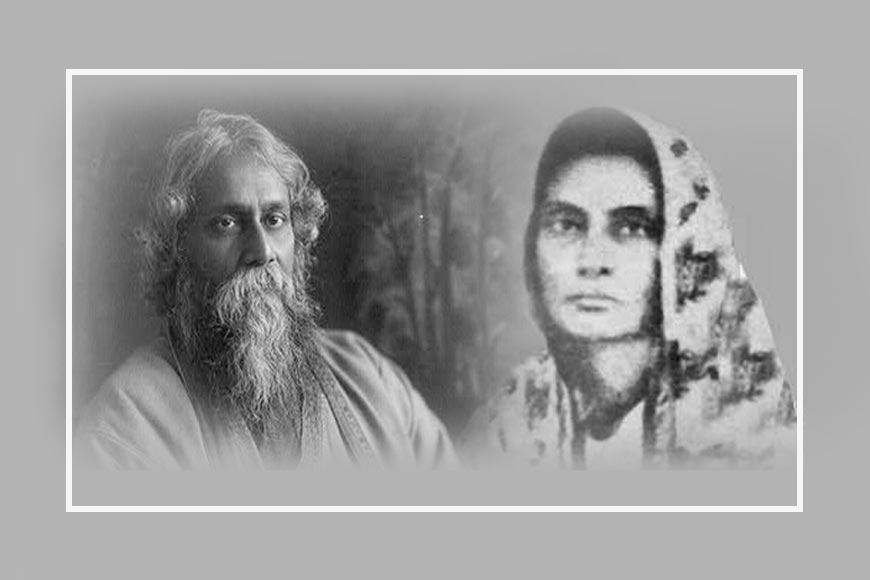Hemantabala, Rabindranath Tagore’s dear Penpal – GetBengal Story

Hemantabala had the moxie to challenge Nobel laureate Rabindranath Tagore in a battle of letters. She would write her missives using rhyming words and send them to Tagore at his address. Rabindranath was a renowned figure and used to receive hundreds of letters daily, so much so that he had a secretary, Sudhir Chandra Kar, whose task was to sift through the letters, store them, open them, reply to them, etc. Tagore was unaware that Sudhir Chandra kept the letters, which were unrelated to work, in a separate file. That file was known as ‘Pagla File’ or ‘Mad File’ as the letters stored in it were like the mad wind that blows without a purpose yet continues to flow.
The first letter sent by Hemantabala also made way to this ‘Mad File.’ In the second letter, she signed the mail as ‘Khadotbala.’ In the third letter, the same woman proclaimed herself ‘Jonaki Devi.’ Maybe this continuous effort to reach out to Tagore caught the great bard’s attention, and he finally replied to her letter on February 8, 1931.
“Dear Jonaki, accept my best wishes.”
She might have been waiting for such a dispatch to arrive, just like Daakghar’s Amal. She preserved this letter as the best reward she ever got. The girl’s name is Hemantabala, and she became Tagore’s penpal.
Hemantabala’s childhood and teenage years were spent on Bechu Chatterjee Street. Her father, Brajakishore Roychowdhury, and mother, Anantabala Devi, were very liberal. Brajakishore was a musician, and Hemantabala would play the ‘dhol’ along with him. Like the boys she was raised with, she was given work in the garden; she played bat and ball; and she participated in cricket matches at the house with all the boys and the servants. She even tried to smoke a hookah, just like men did. All these activities used to frighten her mother a lot. So, she used to teach her the household chores in the kitchen, from understanding spices to cooking vegetables. Coming from a Hindu family, she even questioned the idol worship during Durga puja and asked the purohit if the idol eats the offerings as they are made of mud.
She had a curious and sensitive mind, which made finding a traditional match for her difficult. She was married in 1904 to the Maharaja of Natore Jagadindranath Roy’s nephew, Brajendrakanto Roy. But Hemantabala could never accept the ways of her husband. She did not want grandeur and opulence; rather, she was after intellectual freedom.
She kept Tagore’s books and letters forever, which acted as a source of motivation. As the daughter-in-law of a typical Zamindari household, she felt extremely left out. She could only make friends with one of her in-laws, Brajasundori, who also secretly wrote essays and kept them hidden in a box. Though Hemantabala always questioned idol worship and was attracted to the concept of Brahma worship, as the wife of a zamindar, she was so bored that she took up praying to the Kuldevta.
She fell in love with Madan Mohan and Shyam Sundor. Although she became a mother at the age of 15, she could never be domesticated. When she returned to her maternal home, she refused to go back, even when her husband came to take her. They then filed for divorce, and Hemantabala even sent a letter of consent to her husband when he threatened to marry again. Hemantabala was undeterred.
Later in life, she became a follower of Shri Kishorenanda Maharaj. Rumours claimed she did so because of his resemblance to Rabindranath Tagore. Some say her demeanour towards Sri Thakur Maharaj crossed all lines and that despite her husband's many attempts to bring her back into the family, he could not.
After the death of Maharaj, Hemantabala bid farewell to her religious scripts and took to Tagore’s literary works. She found a similarity between Panchak of Tagore’s Achalayatan and her own life. She rediscovered herself as ‘Durantabala Akash Nari.’ This was the time when she wrote a letter to Tagore. She wanted a poem from Tagore. Rabindranath must have liked her style of writing and wrote back with a poem called ‘Niharika.’ At first, Hemantabala could not believe her eyes. Tagore had written a poem for her in his own handwriting and sent it to her! This opened the floodgates of letters. She started writing letter after letter to her ‘Kobi Dada.’ For Tagore, she was ‘Jonaki.’
For 10 long years, they kept writing to each other, which gave birth to around 264 precious letters that have found place in Tagore literature in the 9th volume of his letter collection. These are not emotional letters; rather, their discussions revolved around idol and non-idol worship. Though in the beginning Hemantabala did not expose her true identity, she eventually revealed herself to the poet. They even met and exchanged gifts.
Despite the pure foundation of their relationship, there were people who criticised them and believed Tagore would turn Hemantabala into a Brahma worshipper. Hemantabala's story illustrates how a woman might have chosen intellectual freedom over the security of an unhappy married life and refused to be confined to the Andarmahal.
Data source: ‘Robi O Jonaki’ by Jayanti Sanyal











